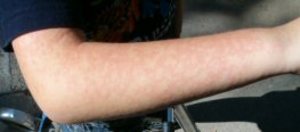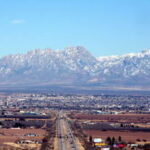My grandson lives in New Mexico and comes to spend the summer with us in Southern California. I don’t want to say I’m overprotective, but he is my only grandson. Imagine my concern when I saw this terrible red rash all over his body, and had no idea the cause. After talking to his parents, trying to figure out if I had given him or used something to cause an allergic reaction, I decided to take him to the local emergency room. Thankfully, it wasn’t serious, but since I had never heard of fifth disease, I had a lot of questions.
Fifth Disease (Erythema Infectiosum) is a relatively common childhood disease and occurs in most children between the ages of 5 and 15. It usually starts with the child developing a low grade fever and mild cold-like symptoms. After these symptoms disappear, the child develops a red rash on their face. The rash looks as if the child has been slapped in the face. Shortly after, the rash will spread to the trunk, arms and legs and will have a lacey net-like appearance. The duration is usually 1 to 3 weeks, and most younger children will not appear to be sick, nor will they complain of discomfort or itching.
Fifth Disease is caused by the Parvovirus B-19 (not to be confused with the pet variety of the Parvovirus). It cannot be passed from human to animal or vice versa. The rash reacts to stimuli from the sunlight, heat, exercise or stress. Other symptoms may be swollen glands, red eyes, sore throat, diarrhea, or unusual rash that looks like blisters or bruises. In older children and adults, the rash may be followed by joint swelling or pain often in hands, wrists, knees or ankles.
The child may be contagious before rash appears, either during incubation period or when they have the fever and mild respiratory problems. Because the rash of fifth disease is an immune reaction (a defense response launched by the body against foreign substance like germs) that occurs after the infection has passed, a child is usually not contagious once the rash has appeared.
Because Fifth Disease is viral, medication will not be necessary. There is no vaccine available for this disease. Complications are rare and this illness is quite benign. However, it can cause severe problems with children that have weakened immune systems. It may temporarily slow down or stop the body’s production of red blood cells causing severe anemia. It can also be a threat to pregnant women, as it can cause problems to the fetus. The best prevention is to practice good hygiene to prevent the spread of germs.
About 50% of adults have been previously infected and are immune. Once you have contracted Fifth Disease, it is very unlikely you will have a reoccurrence because your body will develop an immunity. During outbreaks, about 20% of adults and children who are infected do not develop any symptoms.
I know it sounds strange to say I’m glad my grandson had Fifth Disease, but considering his past health issues, this was quite a relief. Because of kidney problems since the age of two, he was almost always on a low dose antibiotic and had surgery at age four. We are so fortunate to live in a large city with a terrific children’s unit at one of our local hospitals. Although Fifth’s Disease is usually quite harmless, I would still recommend taking your child to the doctor at the first sign of the symptoms.
I did a search on the internet and found a lot of useful information from webmd.com and also kidshealth, however, I didn’t find a picture that really shows the rash. Thanks to my grandson (and with permission from his parents), I took a close picture of the rash on his arms. I hope it can help others to better identify Fifth’s Disease.
One thing I did find on webmd.com was the interesting way Fifth’s Disease was named. It originated in 1905, when a French physician assigned numbers to the common childhood diseases characterized by rashes. For example, measles was first disease, scarlet fever was second disease, rubella was third disease and so on. Eventually, the numeric names for these diseases were replaced, except in the case of Fifth Disease, which remain the same today.







